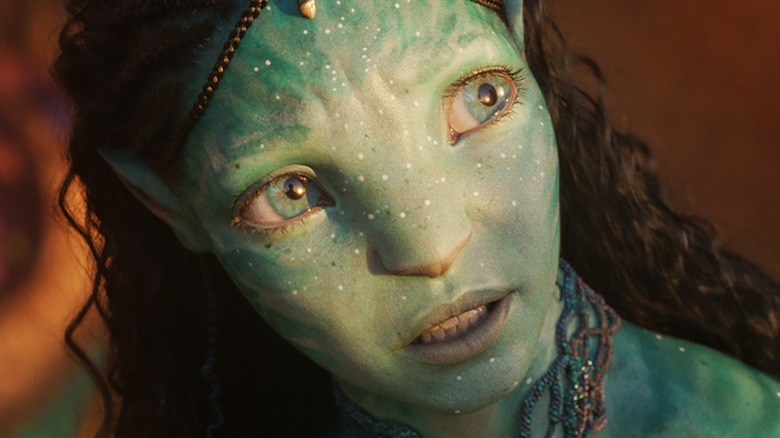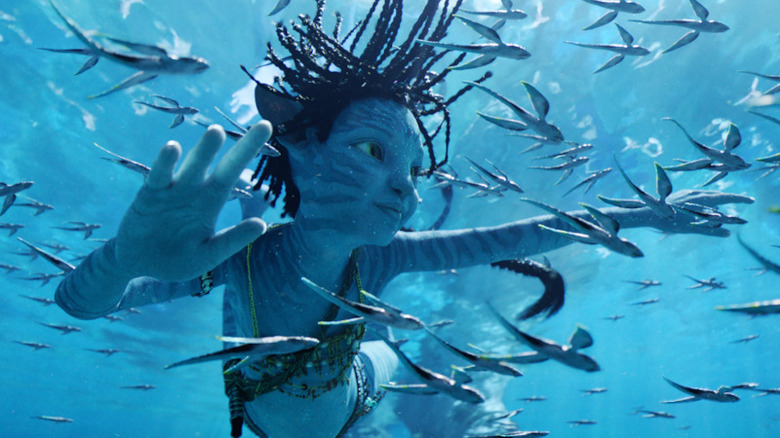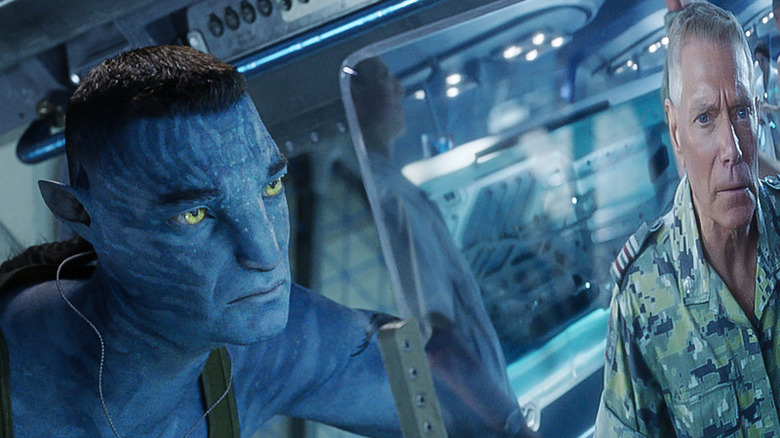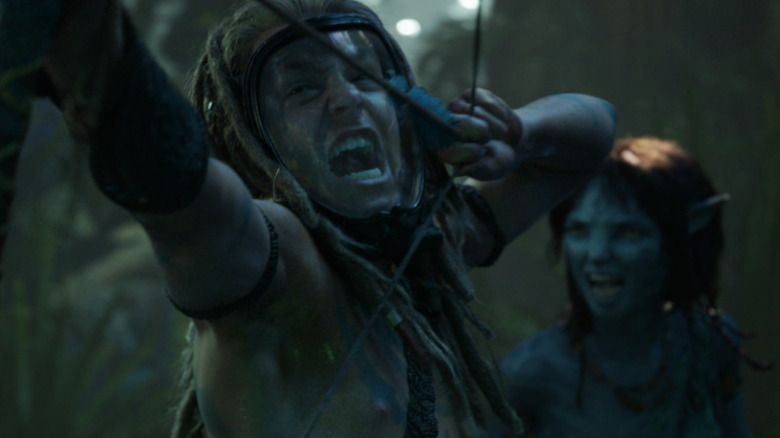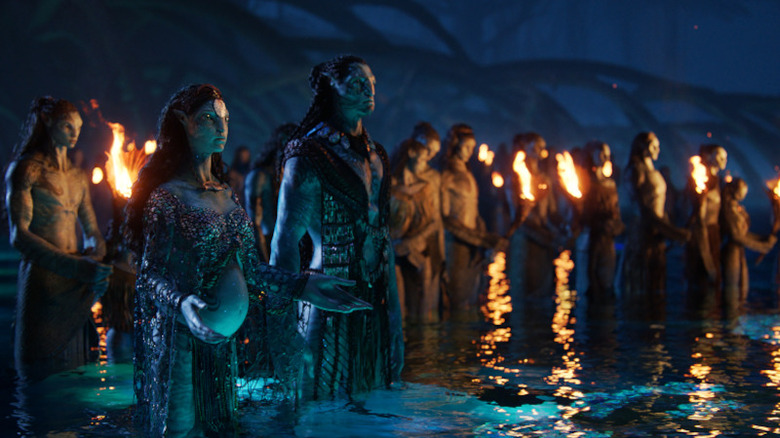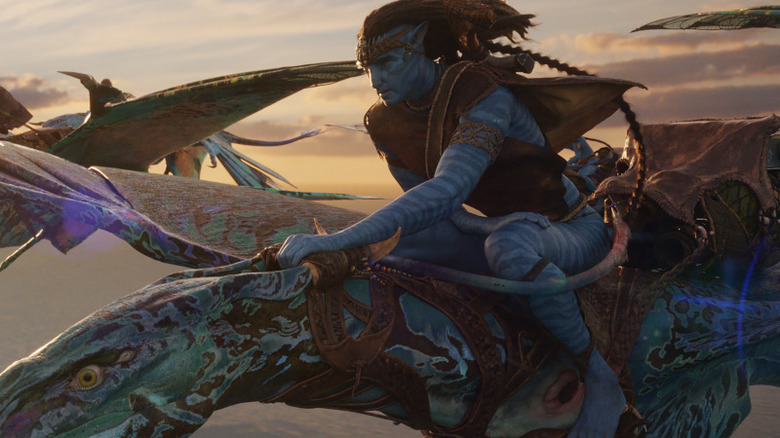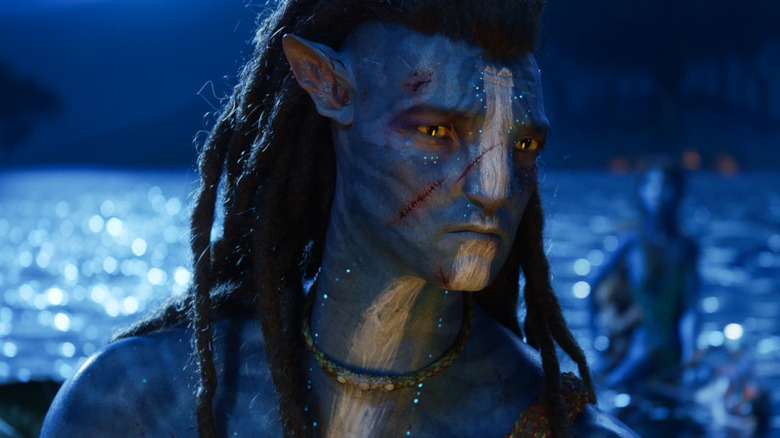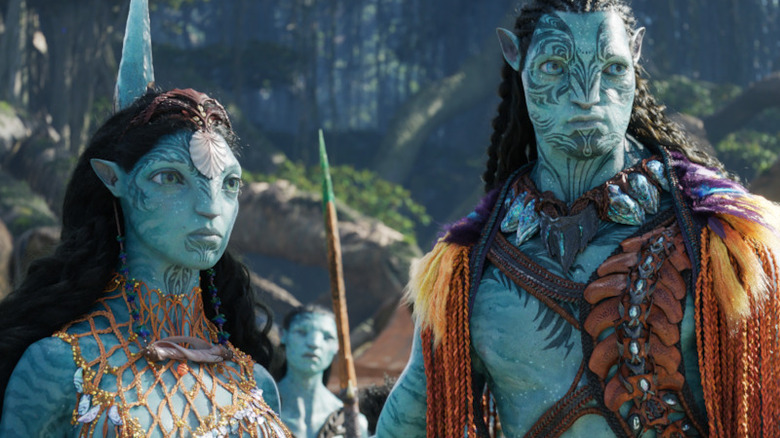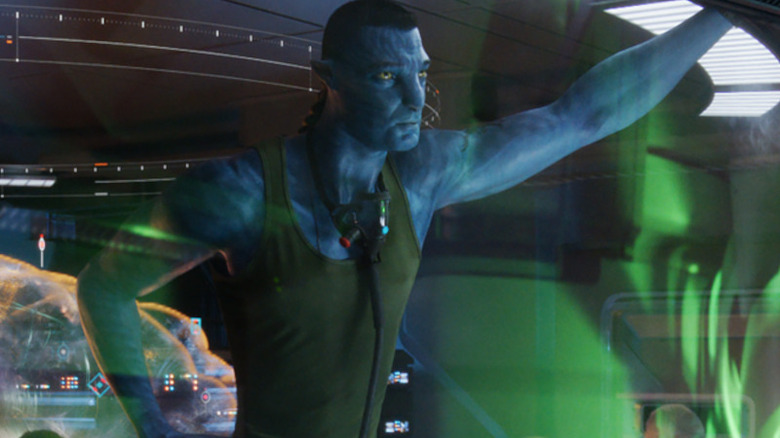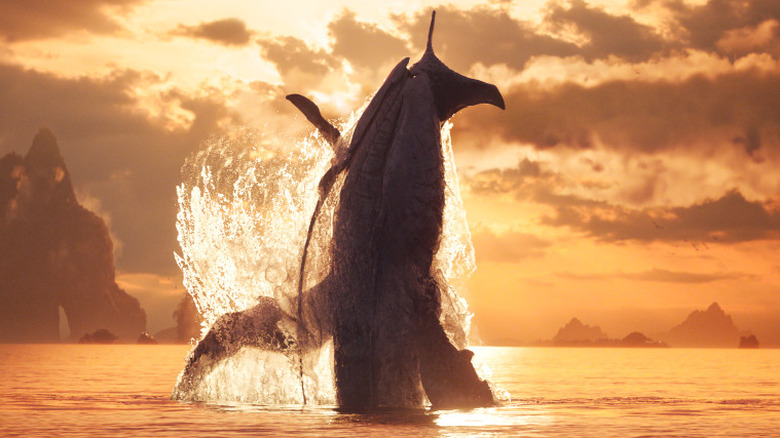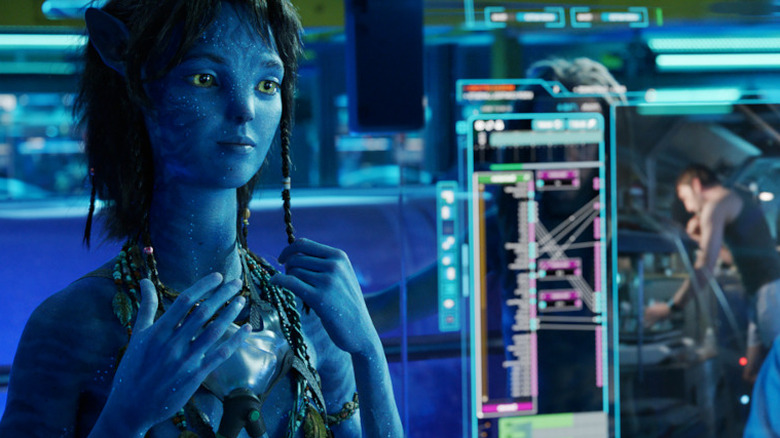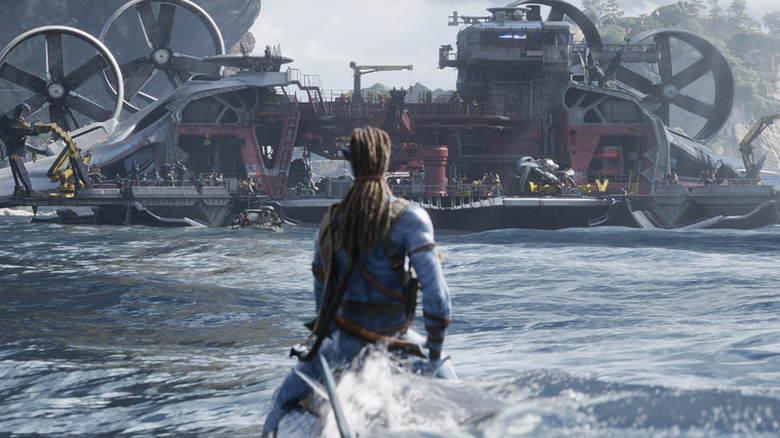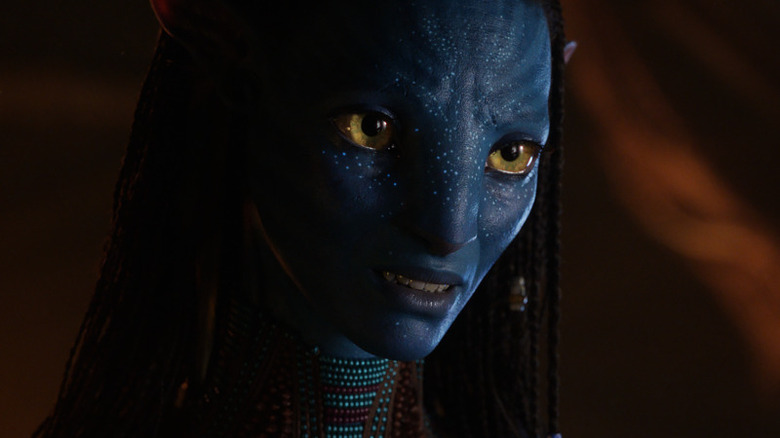Avatar: The Way Of Water's 6 Best And 6 Worst Things Ranked
2009's action-packed sci-fi epic "Avatar," still the highest-grossing film of all time, was directed and written by genre mastermind James Cameron, best known for other classic sci-fi action films such as "Aliens" and the first two (and only good) "Terminator" films. Set in the far future, "Avatar" follows Jake Sully (Sam Worthington), who has his consciousness transferred into the body of a "Na'vi" — a nine-foot-tall, slender blue alien — using it as an eponymous "avatar." Jake is an Earth soldier sent in his new Na'vi body to help subdue the native population of the planet Pandora. That is, until Jake falls in love with the strong, proud warrior Na'vi Neytiri (Zoe Saldana) and decides to help the Na'vi fight off the human invaders.
13 years later, the long-awaited "Avatar" sequel — "Avatar: The Way of Water" — follows Jake, Neytiri and their children as they fight to protect Pandora from human invaders once more. Along the way they'll all meet new, exotic alien creatures, and even a new tribe of Na'vi.
The delay between films was partly caused by Cameron working hard to develop new technology specifically made for shooting the sequels, such as camera rigs that could film motion capture performances underwater (via GQ). The production was also hit by many other challenges, with the release date constantly getting pushed back, the budget ballooning, and the global COVID pandemic throwing the movie industry into turmoil. But now that the film has finally been released, let's take a look at the best and worst things about "Avatar: The Way of Water."
WARNING: SPOILERS FOR "AVATAR: THE WAY OF WATER" FOLLOW.
Best: The VFX are mostly great
James Cameron is well-known for being at the forefront of advancing the tech behind visual effects in film, especially with regards to using computer-generated images (CGI). While there have been computer-generated visual effects in films going as far back as 1973 with the original "Westworld" (via Empire), Cameron is famous for continuing to push the technology further with each successive project. For instance, in 1989's "The Abyss," Cameron used — at the time — state-of-the-art CGI to create the now-famous "water tentacle" with digitally-mapped 3D faces of the actors. He then created the first partially-CG main character in Robert Patrick's liquid metal T-1000 form in "Terminator 2: Judgment Day," and later pushed the tech once more in 2009's "Avatar."
It must be said that the CGI in "Avatar: The Way of Water" is indeed pretty impressive. While the visuals in the original "Avatar" were cutting edge at the time, they — like a lot of CGI effects in films before it — have shown their age a bit. However, the advancement in visual effects technology between the first "Avatar" and "The Way of Water" is palpable. It is especially noticeable when the film focuses on the Na'vi's facial features, or anything involving the physics of water. Not only that, but there are many effects-heavy scenes in the film, which — coupled with filming in a higher frame rate (via Variety) — makes it feel like you're literally on Pandora.
Worst: The VFX are sometimes really bad/distracting
It's undeniably true that there is some stunning VFX work being done by the New Zealand-based studio Weta Digital in "Avatar: The Way of Water." This includes the aforementioned CG renderings of the Na'vi's motion-captured facial features, the state-of-the-art water simulations, and the implementation of high-frame-rate CG shots, as well as rendering new Pandoran creatures, tribes of Na'vi, and more unique environments.
Unfortunately, as in a lot of modern blockbusters, there are also some VFX shots that were obviously given more care than others. Despite a long-gestating 13-year gap between "Avatar: The Way of Water" and the original "Avatar," there's still not an infinite amount of time to design, plan, and render each shot — especially for a film that is mostly CG-animated, with only a few live-action actors and physical locations in it. This is all exacerbated by the fact that director James Cameron insisted on created new tech specifically for the film — which meant the release date kept being pushed back, seemingly indefinitely — but also meant that research and development for the new tech inevitably cut into rendering times for the individual shots (via Time).
This is not to mention the lack of unionization in the VFX industry that leads to artist burn-out, fast turnarounds, and outsourcing some shots to VFX houses offering the lowest bid, rather than the best quality (via Gizmodo) — which is admittedly an industry-wide issue, and not just relegated to "Avatar: The Way of Water." But still.
Best: Great action sequences
James Cameron has had a prolific career as an A-list director, and one of the main things he's known for is his amazing action scenes. Even his epic period drama "Titanic" — which focused most of its three-hour-plus runtime on a budding romance — still had an intense, pulse-pounding 40-minute climax, featuring some of the best action sequences in cinema history to this day. Even the most fervent and vocal detractors of the first "Avatar" had to admit that the action sequences were a stand-out (via Rotten Tomatoes).
"Avatar: The Way of Water" is no exception. There are so many great action set pieces in the film that rival, and arguably surpass, the 2009 original. This includes an exciting futuristic train heist near the beginning of the film, a scene where the evil RDA corporation chases down a herd of the sentient whale-like tulkun, and the climax on the ocean where Jake Sully leads his family and the marine-based Metkayina tribe against a newly-resurrected Colonel Quaritch (Stephen Lang) and his gang.
The finale in particular is a really breathtaking sequence, and showcases why Cameron is the top of the game in terms of action genre cinema. The blocking is clear and precise, the spatial orientation is always legible, and there's no overuse of either shaky-cam or the overdone Zack Snyder-esque slow-down/ramp-up technique.
Worst: The indulgent runtime isn't justified
James Cameron is no stranger to having long runtimes for his films. 1997's "Titanic," for instance — which Cameron also wrote and directed — was three hours and 14 minutes. Even the original "Avatar" wasn't anemic either, with a two-hour and 41-minute runtime to its name.
While "Avatar: The Way of Water" may not be the longest film in Cameron's career — clocking in at three hours and 10 minutes — it's still one of the longest mainstream Hollywood films in recent memory, with only "Avengers: Endgame" coming close at a minute over three hours. This is not to say that long runtimes are inherently bad — far from it. This year's blockbuster Tollywood period action-adventure film "RRR" ran for three hours and seven minutes, and is one of 2022's most financially and critically (via Rotten Tomatoes) successful films worldwide. However, "RRR," along with most of the three-hour-plus epics from decades past, at least had intermissions, which is not the case for modern theatrical films. To be fair, James Cameron has suggested seeing the movie multiple times if going to the bathroom is a problem ... though that seems to be a solution that's more than a bit self-serving (via Empire).
Best: The imagery is beautiful and unique
Whatever critics might say about the quality (or lack thereof) concerning the visual effects in "Avatar: The Way of Water," the art direction on the film is at least consistently phenomenal regardless. Honestly, the style of "The Way of Water" truly evokes the aesthetic of the old Lisa Frank Trapper Keepers from the '80s and '90s — and that's a good thing. The film is just so full of vibrant, saturated, and bright colors that nothing else that has come out in cinemas for the last few years looks quite like it.
The production design is frankly next level, and stands head-and-shoulders above a lot of other big-budget sci-fi films of the same caliber. There's almost no comparison to the amount of detail that James Cameron has put into building every single nook and cranny of Pandora. This includes the idyllic coastal Metkayinan villages and the militaristic RDA corporate facility that contrasts greatly with the naturalistic Pandoran landscape surrounding it.
The various cool and exotic alien creatures in the sequel are often a sight to behold as well, in particular the sentient whale-like tulkuns, as well as the tsurak, or the "skimwing," creatures that the Metkayinan Na'vi tribe ride which are similar to the flying ikran from the first film.
Worst: The white savior problem still persists
One of the biggest issues with the first "Avatar," that many critics rightfully latched onto, was the story's inherent "white savior" issue (via Black Nerd Problems). While pretty self-explanatory, the term "white savior" refers to an extremely outdated — and arguably white supremacist — narrative trope in fiction, where a white person joins a group of marginalized people, and instantly becomes the best of them. It's related to other unsavory and hateful beliefs, such as the patronizing concept of the "white man's burden" (via TV Tropes).
This fits the story of the original "Avatar" to a tee, as a white man named Jake Sully becomes part of the Indigenous-coded alien Na'vi tribe on Pandora, and ends up not only being the best of them (conquering a particularly stubborn ikari that the other naturally-born Na'vi could not), as well as literally becoming their leader.
To be clear, this is not to say that "Avatar" is intentionally hateful or anything like that. But it's not great when the film nonetheless reinforces harmful narrative tropes like "the white man's burden" and "the noble savage," which fit the depiction of the Na'vi as well.
Unfortunately, "Avatar: The Way of Water" does little to alleviate these problems, and in fact compounds them. Jake ends up leading an attack on the humans with not just his own family, but also commanding the literal king of the Metkayina Na'vi tribe as well. His negligent actions also lead directly to the devastation of many Metkayina villages, which never amounts to much in the way of consequences for him.
Best: Na'vi inter-tribe conflict is interesting
James Cameron is known for making some of the best sequels of all time, whether it's following up Ridley Scott's classic sci-fi/horror film "Alien" with one of the best sci-fi/action flicks ever in "Aliens," or continuing his own "Terminator" tale with "Terminator 2: Judgment Day," that somehow made Arnold Schwarzenegger's deadly Terminator loveable enough to cry over.
In both cases, Cameron was able to find a way to turn those original stories on their heads — even switching entire genres — but also making sure that what made those films work in the first place remained intact, such as keeping the xenomorphs scary, or letting both "Terminator" films be explosive, bloody, and thrilling. Same goes for "Avatar: The Way of Water."
Cameron keeps what worked in the first film — the amazingly-rendered environments, the anti-corporate message, and the deep spiritual mythology — and adds some new, much-appreciated wrinkles. One of the most narratively satisfying additions to the sequel is the inclusion of the Metkayina clan, an aquatic-based Na'vi tribe living on the beaches near Pandora's oceans. The initial tension between Jake and the Metakayina, when the Sullys first arrive looking for sanctuary, as well as a sense that the Na'vi tribes have long-standing prejudices against each other, makes the world feel much more real and nuanced. It also raises the stakes by making fighting off the humans that much harder, which also reflects Indigenous struggles against colonization in our world (via National Geographic).
Worst: Re-using the first movie's villain is lazy
Stephen Lang is a great actor. In many of his roles, he's able to effortlessly exude extreme intensity and menace, including his performance as "Avatar" main antagonist Colonel Miles Quaritch. In that first film, Quaritch thematically represents the military arm of capitalistic imperialism, as the massive corporation RDA contracts the Earth military to aid in Pandora's colonization efforts — i.e. wiping out or enslaving the native Na'vi population to ease efforts in exploiting the planet's special resource, unobtainium. Lang does a great job in the role: he's just the right mix of arrogant, strong-willed, and scary to be a worthy adversary for the heroes.
However, he's also a bit one-dimensional. It's fine for the story that "Avatar" tells, which is more about Jake Sully discovering and learning to love Pandora and the Na'vi; it makes sense that more screen time and narrative real estate is given to that plotline, rather than developing Quaritch as a character. But unlike fun or interesting villains like Loki or Hannibal Lector, Quaritch is just not compelling enough to bring back. As written, he was always just a stereotypical military guy. To be fair, Cameron does attempt to add layers to Quaritch in "Avatar: The Way of Water" — particularly his relationship to his left-behind son, Spider (Jack Champion) — but even that's hacky and cliché in its own way, hearkening back to the fact that so many villains have daddy issues already (via TV Tropes).
Best: The banished tulkun
Like any good spectacle-filled action epic, there are a lot of applause-worthy moments sprinkled throughout "Avatar: The Way of Water." However, none are as crowd-pleasing as the scene where a banished tulkun — a massive, sentient whale-like creature that is a vital part of Metkayina culture — jumps out of the ocean to completely decimate an RDA-funded tulkun-hunting vessel.
Honestly, the banished tulkun character – who is befriended by Jake Sully's youngest son, Lo'ak (Britain Dalton) — is a highlight of the film in general. The bond that forms between Lo'ak and the banished tulkun has all the hallmarks of a classic "A Boy and His X" story (via TV Tropes), but done extremely well. The subplot takes its time to tease out the banished tulkun's tragic backstory, as Lo'ak initially discovers the tulkun covered in injuries with remnants of Earth tech embedded in its hide. The film's extended runtime also allows for the tulkun and Lo'ak's deep friendship to grow naturally — one of the few times the runtime works in the film's favor – and makes the tulkun's redemption in helping the Na'vi fight the humans that much more satisfying.
Worst: Sigourney Weaver's voice is too distracting
As an actress, Sigourney Weaver is a nerdy fan-favorite, starring in many classic sci-fi genre staples over the years such as "Galaxy Quest," all but one "Ghostbusters" film, and — of course — as Ellen Ripley in the "Alien" franchise, which includes 1986's "Aliens," written and directed by none other than James Cameron.
Weaver returned to star in Cameron's "Avatar" in 2009, where she plays Dr. Grace Augustine, a highly-regarded xenobotanist on Pandora who is also the head of the "Avatar Program" that put human minds into Na'vi bodies. Dr. Augustine is also sympathetic to Pandora and the Na'vi, unlike a lot of her human colleagues. Unfortunately, she dies before the end of the first film, after an attempt to resurrect her at the Tree of Souls fails.
Surprisingly, like Lang, Weaver returns in "Avatar: The Way of Water." However, unlike Lang, Weaver returns as a new Na'vi character named Kiri, the adopted teen daughter of Jake Sully and Neytiri. Unfortunately, despite her best efforts, Weaver playing a teenager is simply too distracting to work. Weaver, of course, is an amazing actress — and it's not even a bad performance, in isolation — but, rather, it's the fact that she is starring alongside actual young adults as her siblings. Though her CG Na'vi form looks like a young Sigourney Weaver (albeit giant and blue), the voice doesn't, and it comes off as unsettling more than anything else.
Best: The anti-capitalist message
Whatever James Cameron's faults as a storyteller, his lack of subtlety is not one of them. Say what you will about "Avatar," but the themes of anti-capitalism are very clear and well-defined in that film. The audience unambiguously witnesses the violent, devastating effects that careless, untethered capitalistic greed has on the beauty and balance of nature, and how its lust for infinite growth also leads to the genocide of entire cultures, like the Na'vi (or Indigenous tribes in real life).
This anti-capitalist messaging is thankfully maintained in "Avatar: The Way of Water." In fact, that message is expanded upon in the new film. We find out that there's a whole operation run by the RDA, where they round up and slaughter entire families of tulkun — sentient beings that are said within the story to be potentially smarter than humans and Na'vi combined — simply to extract a single vial of brain fluid. Meanwhile, the corpse of the whale-sized creature is left to rot in the ocean. This is reminiscent of the wasteful and inhumane whaling practices on Earth today.
Worst: Neytiri is sidelined
One of the best characters from the original "Avatar" film was the proud and strong Na'vi warrior Neytiri, with Zoe Saldana of "Guardians of the Galaxy" fame doing the vocal and motion capture performance for her. In fact, Neytiri's beauty, strength, and bravery are the main reasons that Sam Worthington's Jake Sully switches sides, deciding to protect the Na'vi from the invading human army. She is Jake's — and the audience's — guide to the wondrous world of Pandora, and her and Jake's love story is the emotional crux of the entire first film.
Unfortunately, in "Avatar: The Way of Water," Saldana's Neytiri is pretty much sidelined for most of the film's arduous runtime. She mostly plays the cliché role of the concerned wife and mother, usually in the background fretting while Jake and her children get to do all the narrative heavy lifting. There are even some very uncomfortable moments when Jake forcefully shuts her up after she brings up valid complaints. Yikes.
To be fair, the sequel shifts the focus away from Jake as well, since the story is a generational one about their kids, instead of them. But Jake still gets a lot more to do in "The Way of Water," while in the first one, Neytiri and Jake's importance to the overall narrative was much more equal. Also, while it's true that Neytiri gets to be an awesome warrior during the climax, it's also kind of a "too little, too late" situation at that point.
